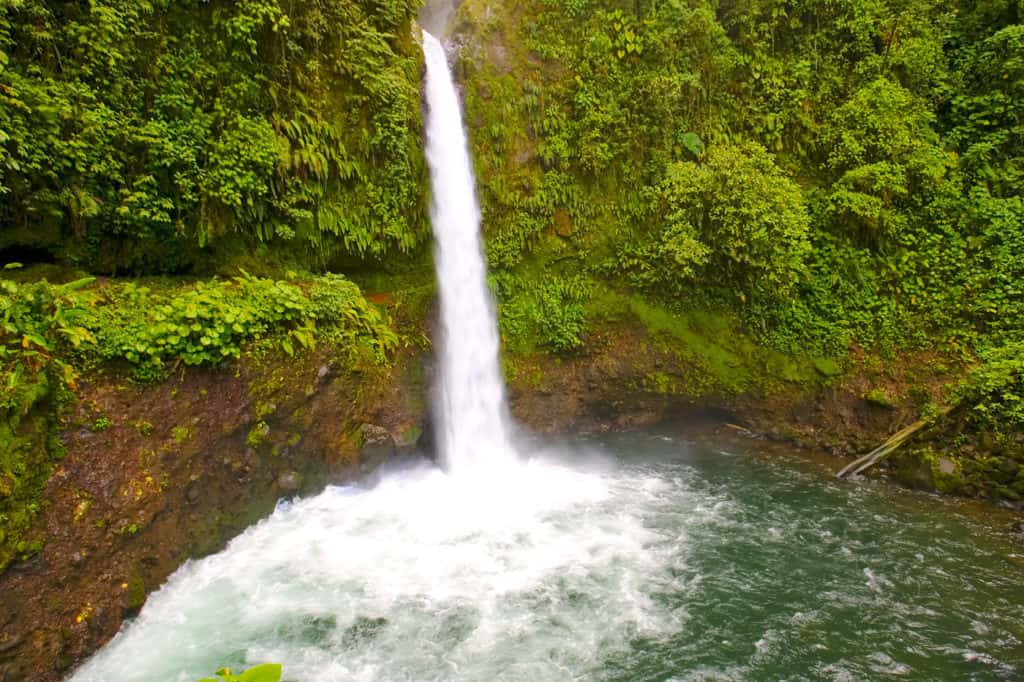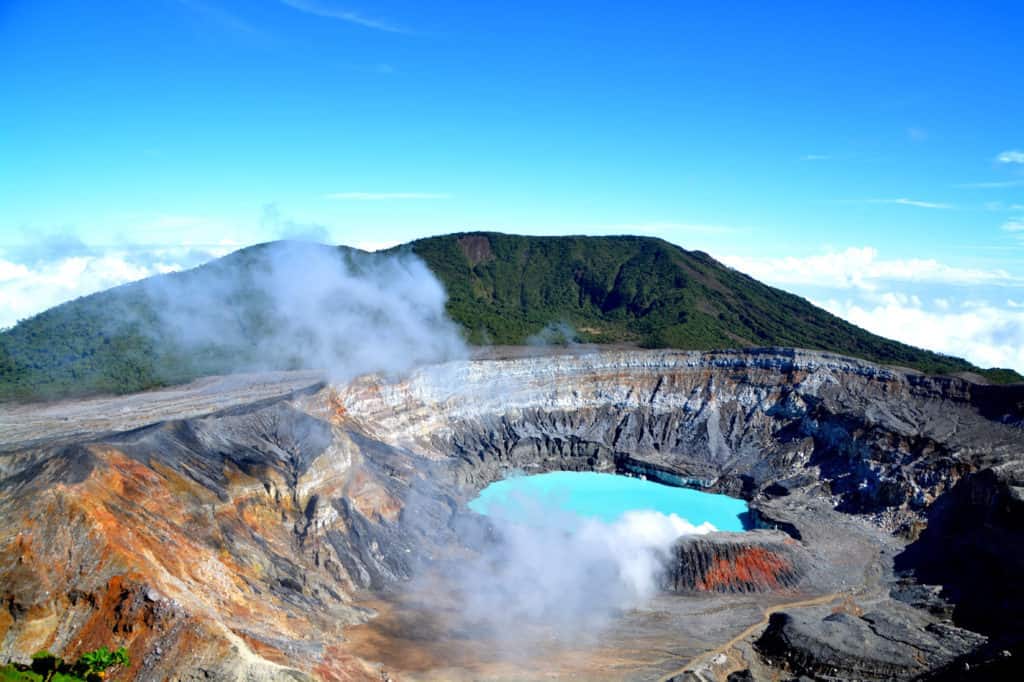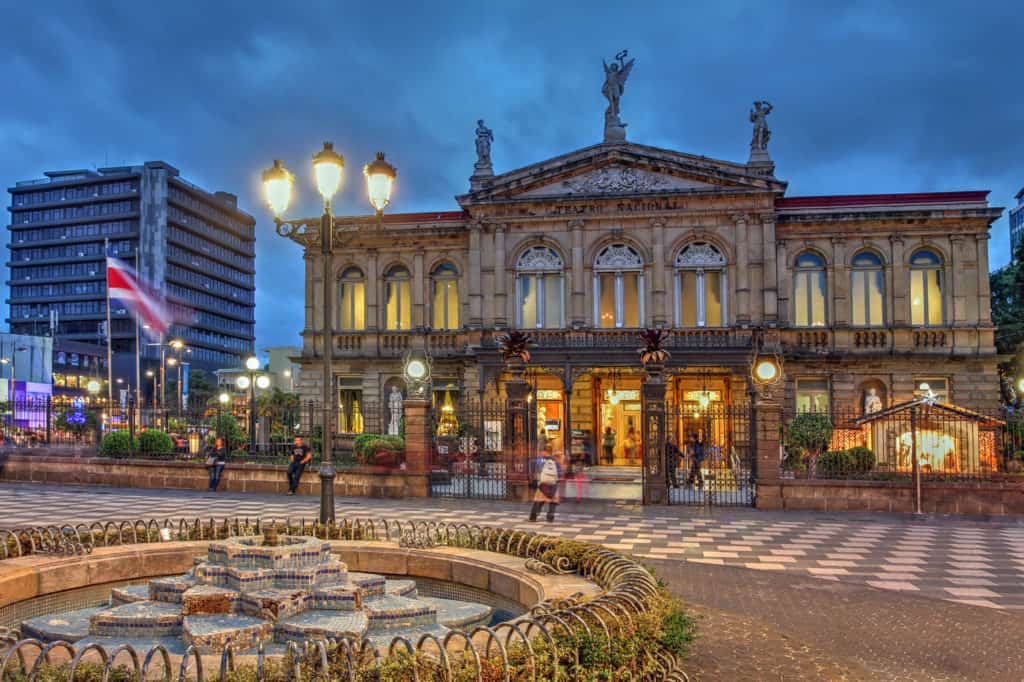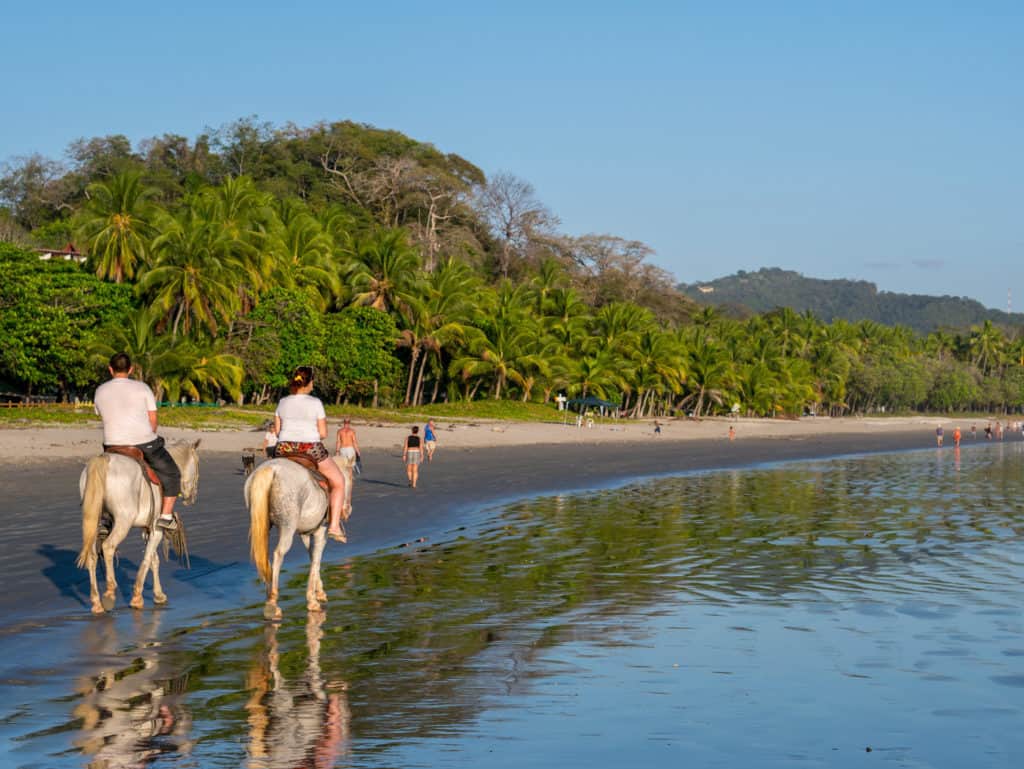Towering 8,900 ft. (2,713 mt.) above sea level, home to the world’s second-largest volcanic crater, and site of fumaroles, lagoons, and otherworldly cloud forest, Poás Volcano is, unsurprisingly, Costa Rica’s most visited national park. Our Poas Volcano travel guide fills you in on everything you need to know about this incredible volcano its surrounding cloud forests, waterfalls, and coffee country.
tlp: The park currently closed due to volcanic activity. When it reopens, Poas Volcano National Park is open daily until 3:30 p.m., but you’ll have the best chance of clear crater views on early mornings, especially if you’re visiting May-December.
Overview
- Area: Central Valley
- Average Temperature: Sweater weather! 55º-70º F (15º-21º C)
- Closest Airport: Juan Santamaría International Airport (SJO), 1 hour
- Can’t-Miss Attractions: Poás Volcano National Park (active volcano, hiking), La Paz Waterfall Gardens (wildlife, hiking, waterfalls), Doka Estate Coffee Tour (family coffee plantation)
- Hot Activities: Hiking and Nature Tours
- Great for: Families, Nature Lovers, Hikers, Budget Travelers, Airport Layovers
Costa Rica is part of the infamous Pacific Ring of Fire. There are five active volcanos in the country, and Poas Volcano is the most beautiful and accessible by far.
“For those of you who believe that volcanos only offer barren landscapes, be prepared to have your mind blown. The vegetation surrounding the main crater and Botos Lake is amazing!”
Spanning some 16,000 acres, it is one of the most developed and visited National Parks in Costa Rica. Its proximity to San José, and the International Airport in Alajuela, make it the perfect destination for a day tour.
The Poas Volcano features the world’s second largest active crater measuring 0.9 miles wide and about 300 feet deep. One of the most trilling aspects of this natural wonder is that the observation point allows you to stand right at the edge, and look down on the rain fed turquoise lagoon. The Park offers hiking trails that are ideal for exploring the unique flora of this area, as well as a modern visitors center with a small museum and snack bar. The Park is open to the public every day of the week from 8:00 am to 3:30 pm, entrance fee is $15 per person.
Additionally, the area is home to La Paz Waterfalls Garden Nature Park. This enchanting place is set amidst lush rain and cloud forests where crystal clear rivers flow and cascade down some of the most beautiful waterfalls you will ever see. The countless hiking trails were created for you to experience nature’s extravaganza like you never thought possible.
A trip up to the volcano offers spectacular scenery, full of lush vegetation and quaint little towns. The fertile lands surrounding the park provide the perfect conditions to grow some of the world’s best coffee beans. If you happen to be a fan of this wonderful beverage, you can’t pass up the opportunity to visit Doka Estate, one of the oldest coffee plantations and processing plants in the country.
This Poas Volcano travel guide introduces you to best the area has to offer, from the country’s most-visited national park and wildlife sanctuaries, to cascading waterfalls and some of the world’s best coffee.
What to Do in Poas Volcano
Poas Volcano National Park
When visiting the Poas Volcano National Park, make sure to go with plenty of time so you can tour the visitor center and the museum after your hikes. At the visitor center, there are several interactive exhibits that explain the geothermal and ecological attractions of the park. Since fog can move in quickly, I recommend you leave the visitor center for last.
As mentioned before, the volcano has 3 different craters. Only the main one is active. The main crater is said to be the second widest in the world. There is no lava to be seen, but geysers and fumaroles are common. Unlike most volcanos, here you can walk up to the edge of the crater which is one of the main attractions of the park.
Note: there is a wooden veranda that signals how far you can go, please do not attempt to go into the crater even if it is easy to bypass the veranda. The crater is some 300 feet deep and it is easy to fall and injure yourself.
The geysers activity is not continuous, but when they do occur they can reach heights of 820 feet. Don’t worry, it is nearly impossible to get wet by the hot geyser waters because the crater is so wide and deep. Fumarole activity is constant, as the water from the lagoon seeps through cracks only to evaporate with the heat of the volcano. The rain-fed Sulphur lake at the bottom of the crater is one of the most acidic in the world.
Hiking at the Poas Volcano

Main Crater Trail: From the parking lot, where the visitor center is located, you can walk to the main crater. The road is paved and flat so it is an easy walk and it is wheelchair accessible. It will take you about 10 to 15 minutes to reach the crater depending on how fast you walk.
Botos Lake Trail: The Botos crater is further up than the main crater. The walk up to the lake is a little more of a hike, but still easy. Along the trail you will see informative signs pointing out the different plants and fun facts. As you reach the top, the beautiful jade colored cold water of the lake becomes visible, there is a lookout point where you can sit and admire the scenery. This crater is about a third of the size of the main one, with a diameter of 1,312 feet (400 meters), the lake is frequented by most of the 79-different species of birds that have been identified in the park.
Escallonia Cloud Forest Trail: Most people do not venture on this trail, which makes it even more magical. It begins near the picnic area, and loops around the park at the base of the volcano. It is known as an excellent birdwatching trail. The park is home to exotic bird species like the majestic Quetzals, Toucans, several varieties of Hummingbirds and the elegant Trogon. You can also spot some of the other wildlife, including the two-endemic species of squirrels. The trail gets its name from the escallonia trees; small ever green trees, shrubs and ferns that are abundant in Central and South America.
La Paz Waterfall Gardens Nature Park

This spectacular privately owned nature park is the most visited in the country. It has so much to offer that you may never want to leave.
The falls: The Park features 5 of the most beautiful waterfalls in Costa Rica. The once inaccessible landscape kept these beauties hidden, but now you can view them from safe platforms above, below and in front of the waterfalls. How would you like to take a photo under a waterfall? You can do this when you visit the Magia Blanca waterfall (White Magic) viewing platform. The secure hiking trails offer hundreds of amazing photographic opportunities, perfect for both amateur and professional photographers.
Jungle Cats: The center is home to several of the 6 species of endangered Central American Wild Felines from the elusive Jaguar to the friendlier Pumas. The animals were entrusted to the La Paz Waterfall Gardens after the center who previously housed them lost its funding. The cats could not be released back into the wild for various reasons, but the center’s ultimate goal is to create a suitable program that would enable the animals to live on their own in protected areas.
Butterfly Observatory: The onsite laboratory has over 4,000 butterflies from 25 different species. The laboratory is glass enclosed so you can walk among butterflies no matter what the weather outside is like.
Hummingbird Garden: This could be the only place on Earth where you can see up close over 26 species of hummingbirds. Costa Rica has some 57 species of hummingbirds on record and you can see almost half of them in this beautiful garden. The experience of having these tiny birds fluttering all around you as you stand inches from their feeders is something you won’t have anywhere else.
Birds & more: La Paz Waterfall Gardens also features an aviary where you can hand feed toucans, there are white faced and spider monkeys, a snake and frog exhibit and a two-level trout lake where you can go fishing.
La Paz Waterfall Gardens Nature Park Website
Doka Estate Coffee Tour
The Doka Estate is a family owned coffee plantation that has been producing some of the best coffee beans in the country for over 70 years.
While taking the tour, you will undergo a journey like no other; from the seed to the cup they call it. Learn how coffee is grown, harvested, processed and roasted until it becomes that velvety elixir that most of us require to start our day.
Sarchi
The town of Sarchi is renowned for its craft and furniture making factories. The small town is home to the biggest Oxcart in the world according to the Guinness Book of Records. On your visit to this colorful town you can tour an oxcart factory and buy gorgeous wood crafts and souvenirs.
La Paz & Poas Volcano Travel Guide to Great Bars and Restaurants
Freddo Fresas: On the way to the Poas Volcano you will find this cozy rustic restaurant known for its strawberry smoothies and typical Costa Rican cuisine. Prices are fair and portions are large. Service can be a little slow if the place is really crowded, but it is always friendly.
El Churrasco: Best known for its meat cuts, it also serves typical Costa Rican dishes like the infamous Casado, as well as fresh fish and poultry dishes. The restaurant has been in business for 22 years and has become a staple in the area.
El Descanso: Just before you arrive at the Poas Volcano, you will find this quaint family owned mountain restaurant. Its menu has a wide selection of meat and fish dishes. If you stop here you must try their “Tortilla Aliñada”. It’s a seasoned tortilla with grated cheese baked right into it, served with sour cream.
La Paz & Poas Volcano Travel Guide to Hotels
El Churrasco Hotel: A great budget hotel option, the restaurant el Churrasco mentioned above is part of the amenities of the hotel. Rooms are clean and come equipped with a heater which comes in handy at night. Breakfast is included in the price and parking is free.
Altura Hotel: A unique hotel located some 10 minutes from the Poas Volcano and about 25 minutes from La Paz Waterfall Gardens. The hotel has spectacular views and a one of a kind architecture. This is a mid-range hotel, breakfast is included and Wi-Fi is complimentary.
The Peace Lodge: A wonderful Luxury hotel located on the grounds of La Paz Waterfall Gardens Nature Park. This place is simply amazing. Rooms feature a Jacuzzi, stone fireplace and a shower that can turn into a waterfall with a simple turn of a knob. There is so much to see at La Paz Waterfall Gardens that a day is not sufficient to really take it all in. If you have the budget I highly recommend you stay here and enjoy the beauty this place has to offer.
Location
The Poas National Park is in the Province of Alajuela on the Central Volcanic Mountain Range. It is 37 km (23 miles) NW of San José. Getting there takes about 1.5 hours. If you are taking the bus the ride is closer to 2 hours, as the bus makes a stop in Alajuela.
Weather
The National Park sits close to 8,900 feet above sea level, which means it is above the frost line. Temperatures below freezing are possible, though unlikely. The average temperature ranges from 45F to 70F, and the area receives an average rainfall of 140 inches a year. Dress warmly as the wind blows fiercely around the main crater. The best months to visit are between December and April. It is common for the volcano to cloud over after midday regardless of the season, so visits are best early in the morning to increase your chances of viewing the crater.
Because of the climate, it is best if you wear pants and take a sweater or light jacket. If you are visiting during the months of May through November, rain gear is suggested. Comfortable shoes are a must so you can enjoy the hiking trails. Additionally, it might be a good idea to bring an extra pair of socks in case it rains.
Getting to Poas Volcano National Park
Tours: The easiest way to enjoy this area is by taking a day tour. A visit to the volcano is normally a half day tour, so most operators combine activities to make it a full day tour. You can opt for a Poas Volcano and Doka Estate tour, or one including the town of Sarchi, or even a visit to La Paz Waterfall Gardens.
Bus: There are daily buses to the Poas Volcano which are very affordable. If you only plan on visiting the volcano this is a great budget option. The TUASA bus station is located on Avenida 2, calles 12-14. There is only one return bus and it leaves at 2:30 pm, make sure not to miss it.
Driving Instructions: If you are driving to the volcano from San José, take the Pan American highway to Alajuela. Once in town, follow Calle 2 until it turns into route 130, this will lead you to a town called Fraijanes. From there follow the signs all the way up to the volcano.
Visit Poas Volcano
Because of its proximity to San José and the International Airport in Alajuela, the Poas Volcano is the one of the most visited National Parks in Costa Rica. Perfect for a day or half day tour, the lush vegetation and breathtaking views make this a must-see destination on your upcoming trip to Costa Rica.



